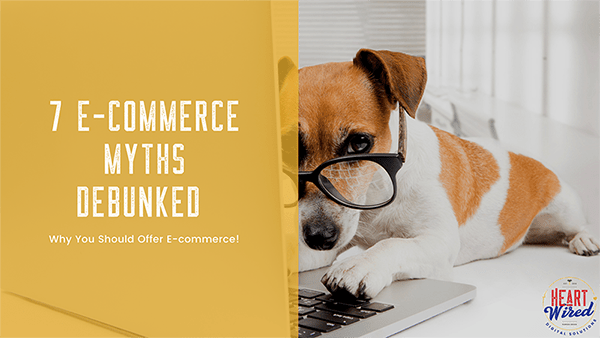
If we have learned anything this year, it is the importance of not only that businesses have a presence online, but also the ability to sell their products or services. Virtually overnight business were shuttered, out of business or scrambling for a new way of doing business. Yet many are still unsure if their website should offer e-commerce or not.
It used to be that e-commerce was thought solely as a way for people to sell tangible or perhaps digital items online.
People that once held the belief that they would never shop for clothes, furniture, car parts, whatever are now shopping that way almost entirely. Even before the pandemic department stores have shut their doors thanks to the emergence of Amazon and other e-commerce powerhouses.
Even while online shopping became a normal way of doing business, there were and still are many thinking that brick and mortar is the ‘only’ way to do business. In fact, we have actually been laughed at ourselves when we have suggested it to business owners, because it would not fit their “model”, or “e-commerce does not work for what we do.”
What if I were to tell you whether you sell physical products, digital products, services or even take donations, e-commerce can fit into your organization. In fact, it likely can increase your sales, no matter what products or services you offer.
This simple concept applies to consumers as well as suppliers and manufacturing. Sure it may mean you won’t need as many sale people in the future, but it also means you won’t need to need them.
Of course there are pros and cons to everything and there are also many misconceptions. It is the misconceptions that I am going to hopefully debunk, and in doing so the cons really won’t amount to much.
Myth #1
You lose the personal touch with e-commerce. Well, not if you are doing it right. Sure you can use AI, chatbots and all kinds of things to simplify the process. The personal touch truly is up to the business and whether they go the extra mile no matter how people buy. E-commerce should be an extension of the way you serve your customers, not a replacement.
Myth #2
Shipping is always so expensive. So is your time, gas and patience when you travel to a store. You avoid traffic, rude customers, pushy salespeople, and can shop in the convenience of your home. All without wasting gas or having to even get dressed. Sure the cost of shipping and handling can be elusive and at times feel like a bait and switch. If you have an idea what the product or service is worth to your customers, pricing them accordingly and being transparent about pricing including shipping, the convenience is worth the extra cost.
Myth #3
Online shopping is risky. If you are shopping at shady places perhaps. Personally I am more comfortable giving my credit card online on an encrypted site than I ever was when they swiped my card and gave me the carbon copy. There are some things to make sure your e-commerce website has to ensure customer safety.
- Make sure you are using a SSL to encrypt transactions.
- Use a hosting company that protect you from hacking, malware, and viruses.
- Provide a privacy policy on your site how you use the customers information.
Myth #4
How do I know what I am really ordering, it might be from China. This is true, actually I just fell victim to this ploy and am still waiting for the product to make it through customs. Yet, again do you research, use a credit card with a protection plan. You can buy plenty of things from China at your local Walmart too, and guess what they ordered them online!
One way to ensure the comfort of your customers is to be transparent about your products or services. If you import, outsource or do anything that may raise concerns, tell them. Being upfront about your practices garner trust and your customers likely won’t care as long as you tell them.
Myth #5
I offer services I don’t need an e-commerce website! So you only like to sell your services in person do you? I mean that means you don’t promote them online, on social media or anything right? Why not give your clients a place to not only read about your products or services, but even schedule and pay for all online, 24/7? Or does that not fit your business needs?
Imagine coming into work and already having your calendar full with new clients, or having orders to ship. All of these activities can happen while you are not at work. Creating a business model to best serve your clients where they are, when they want.
Myth #6
I must always offer a discount to sell online. People that run their business based on offering discounts continually rarely win. Competing on price alone rather than offering more value is a slippery slope for any business whether online or in person.
In a recent KPMG study, a company’s sales team and their customers were asked what they thought were the top purchase criteria. Although, 60% of the sales team put price or discount at the top of the list, only 20% of their customers did the same. It was reported that delivery, reliability, accuracy and quality of service were the most important factors when choosing a supplier, outranking price.
Myth #7
Build it and they will buy. Like any website, any e-commerce site needs a bit more than just a great design and pretty pictures. So many people create sites and then get frustrated. They then fire their web designer because they did not get the ‘traffic’ or sales they wanted. Optimizing your site, whether e-commerce or other, takes skill, time and generally a budget. SEO is just the beginning. Without a strategy you likely won’t see the sales you hope for, at least not long-term.
As shopping online becomes more and more common, and part of the new normal, customers willingness to trust will wane. Click-bait will become more rampant and their ability to decipher a real ‘deal’ will become more difficult. Rather than using short lived strategies that do little beyond burn your cash, build a e-commerce strategy that will last.
We are at the beginning of an economic shift. We will see the the need for brick and mortar locations for many businesses go away. The time is now that your website should offer e-commerce, to prepare for the new way of doing business.
